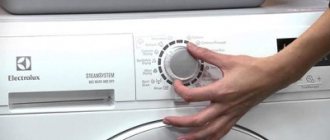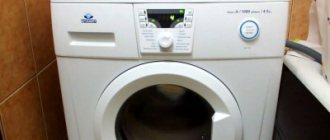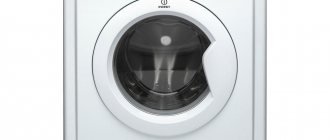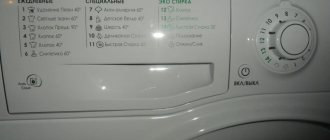The Kandy washing machine is a household appliance with a complex structure. Its service life directly depends on how accurately the user follows the operating rules of the device.
All actions are important, from the first start to the features of caring for the cuff and powder tray.
The article will discuss how to use the Candy washing machine correctly so that it not only works properly, but also washes things well.
First launch of the Kandy washing machine
To ensure that the device does not have to be repaired immediately after first switching on, it must be put into operation correctly. First you need to study the User's Guide that comes with each model.
Then you need to follow these steps:
- Place the device on a flat surface. Adjust its position using a level. If you do not do this, the machine will vibrate strongly and quickly fail.
- Connect equipment to communications. The drain pipe is installed in the sewer pipe, and the inlet hose clamps are securely fixed.
Provide the device with safe access to electrical power.
It is advisable to connect it to the network directly, without using extension cords. If the outlet is located in the bathroom, then it must have a moisture-proof housing.- Remove the shipping bolts that secure the tank.
- Remove tape, film, plastic and foam from the device. Then you should inspect the tank; it often contains additional components.
- Perform the first technical launch. It is necessary to check the functionality of the device and to wash the inside of the machine. Pour washing powder into the tray, set the “Cotton” program, close the drum (it should be empty) and press the “Start” button. During the first wash, you need to carefully monitor the operation of the device to assess the serviceability of the parts and prevent leakage.
This publication will tell you how to turn on the Kandy washing machine.
page WARRANTY……………………………………………………………
Page 2
- Image
- Text
CONTENTS '
p.
GUARANTEE………………………………………………………………………. 65
TECHNICAL DATA……………………………………………………………… 66
OPENING THE DRUM - LOADING LAUNDRY……………. 67
STACKING THE WASHING PRODUCT……………………… 68
AUTOMATIC CHANGE OF THE
WASHING PROCESS – ELECTRÓNICA FUZZY LOGIA…………………….. 69
SELECTION OF THE PROGRAM……………………………………………………………… 69
DESCRIPTION OF COMMANDS ON THE PANEL…………………………….. 70
TABLE OF PROGRAMS……………………………………………………………………. 73
Install the attached
“program label”
the corresponding tongue in
the rear slot of the indicator
window.
64
Preparing for washing
Preparing for washing involves performing the following steps:
- Sorting laundry . It is divided by type of fabric, color, degree of contamination. If there are stubborn stains on your laundry, they need to be pre-treated by soaking them in a stain remover.
- Inspection of things . Before placing items in the drum, you should check the pockets to make sure there are no small objects. Buttons and zippers are fastened, holes are sewn up. If bed linen is to be washed, turn it inside out.
- Estimate the amount of laundry and its approximate weight . Overloading should not be allowed. It’s good if the drum is half empty during washing.
Mode selection
To select a washing mode, simply turn the programmer knob to the desired position. When the controller is installed, press the “Start” button. If necessary, first change the water temperature and spin speed.
Main modes and their designations:
- Two drops and a “+” icon located on the right side. This is a double rinse mode, with its help it will be possible to completely rid the fabrics of detergent.
- Shirt with stains. This is an intensive wash program in which the drum rotates at maximum speed and the water temperature is 90 degrees.
- Triangle and dial. This is a delayed start function.
- A basin and a stream that enters it from a watering can. This is a standard extra rinse for laundry. When this option is enabled, the wash cycle is extended by half an hour.
- A basin with the letter P. Enabling this mode will enable pre-wash.
- Three balls. The program is designed for washing woolen items.
- A basin with the numbers 32 inside. This is a quick wash mode that will last 32 minutes.
- A cloud with an arrow pointing down underneath it. This is a program for washing thick items - cotton and linen. By default, the water temperature will be set to 90 degrees.
It is not difficult to understand the icons representing the program. In general, operating the device is intuitive. Details are in this article.
Washing programs for the Kandy washing machine, video review:
Reasons for appearance
The most common reasons that the SM issues error E03 are the following:
- clogging of the drain hose from the pump to the siphon or other equipment used to connect to the sewer system;
- breakdown or complete failure of the pump;
- damage to the contacts in the water level sensor - pressure switch.
Failure of E03 in SM Candy may also indicate interruptions in the heating circuit. Often the cause of the error is a malfunction in the control unit. Error E03 often appears due to the negligence of washing machine users when the washing mode is set incorrectly. To fix this problem, you just need to make sure that the selected program is correct before clicking the “Start” button.
Instructions for use
To start the washing machine, you need to load laundry into it. When it is inside the drum, the hatch is pressed tightly so that a characteristic click is heard.
The next step is to turn on the machine to the network and select the appropriate mode . If the drain hose has a tap that shuts off the water, it must be turned.
Temperature
In most programs, the washing temperature is set by default, but it can be adjusted if necessary. This is done by pressing a special button.
The minimum washing temperature in a Kandy machine is 30 degrees, and the maximum is 90 degrees. The choice of temperature regime is determined by the type of fabric and the degree of its contamination.
For example, silk and wool items can be washed in cold water, while cotton and linen items can be heated to 90 degrees. The optimal water temperature for synthetic products is 60 degrees.
If you don’t understand which mode is suitable for a particular item, you need to study the label. It contains the necessary information.
Spin
The rotation speed of the drum determines how dry the items will be after washing . The maximum speed that the Kandy machine can reach is 1400 rpm. These values are typical for devices with drying. The standard speed is 1200 rpm.
If necessary, spinning can be turned off completely. This is true when washing delicate fabrics, wool and silk.
To set the desired speed, press the button with the image of a twisted spiral.
Adding detergents
Detergents are added to the powder receptacle, which is divided into several sections . The left compartment is for powder that will be used for the main wash, and the right one for the preliminary wash. Another section is located in the center. It is intended for liquid formulations: bleaches and conditioners.
The video will show you how to turn on the Kandy washing machine and start washing:
Loading detergents
As practice shows, many housewives pour the powder directly onto their clothes before washing, directly into the drum of the machine. This method cannot be considered correct and competent, since the powder granules contain various concentrates that can not only damage or leave a mark on the fabric, but also completely ruin the item. It’s not for nothing that manufacturers of household appliances have provided a powder receptacle; it is simply necessary for proper operation of the machine. The powder receptacle of the Candy washing machine has several compartments:
- the compartment marked with the letter B or the Roman numeral II is intended for dry or liquid washing powder (main wash);
- the middle compartment, marked with the letter A or Roman numeral I, is loaded with pre-wash powder;
- A small compartment with a flower or star designation is provided for conditioner-rinse aid. Please note that you can add the product even during the washing process, but always before rinsing the laundry.
If you plan to use stain remover, bleach, or anti-scale agents, they must be placed in the main wash compartment.
Do not mix up the compartments; incorrect distribution of detergents among the compartments can lead to unsatisfactory washing results. For example, in no case should you pour bleach into the rinse aid compartment; this will lead to the fact that rinsing of things will be carried out not just with clean water, but with the addition of an aggressive agent.
After the cycle is completed
After completing the wash, you must wait for the sound signal to indicate its completion . When the lock indicator on the display stops lighting, the hatch door can be opened. Then turn off the device by pressing the power button and remove the cord from the outlet.
Things need to be taken out immediately, without allowing them to remain in the drum for a long time. Otherwise, fungi will begin to multiply in a humid environment, and the device will smell unpleasant. It is not recommended to close the door tightly after washing; you need to let the remaining water evaporate.
Serial number
For front-loading machines, the serial number is located on the inside of the loading hatch; for vertical-loading models, the serial number is located on the inside of the baseboard or under the hatch door. Sometimes the number is indicated in the device passport and warranty card.
The serial number provides information about the model, year of manufacture, batch, power, voltage consumption. The serial number is also useful when contacting a service center to replace failed spare parts, which can be easily found in the factory database by number.
Features of caring for a household appliance
Caring for your Kandy washing machine is easy. It is enough to follow a few recommendations:
After each wash, it is necessary to remove any remaining water from the cuff;- periodically you need to clean the rubber of the hatch - this is done with a soft cloth and soap solution; if there are signs of mold on the cuff, it is treated with vinegar;
- wash the powder tray - to perform the procedure, it must be removed by pressing on a small tab; if the powder receptacle is very dirty, it is soaked for 20 minutes in warm water with the addition of soda;
- clean the drain filter - small debris and hair accumulate in it; to clean the part, you need to unscrew it and rinse it under running water.
Step-by-step inspection of parts
In principle, any error can cause a basic failure. Try rebooting it. A few minutes after stopping work, hold down the power button and remove the cord from the electrical outlet. After that, put everything back in place and try to start the wash again. If nothing works, then something is really wrong.
Alternatively, the cord or outlet itself may be faulty. Check them with a tester. Although rare, this does happen. Analyze the appearance of your “home assistant”. It is quite possible that some defects will emerge during a visual inspection. If not, you will have to diagnose the insides of the unit.
- Let's start with the engine. It is placed in a special hatch by Kandy manufacturers. Open it.
- Hold the drive and turn the pulley in parallel. Thus, the belt itself will be removed from the large and small pulleys.
- Take an 8mm wrench and remove the motor mounts.
- Before completely removing the engine, remove all wires from it. It is advisable to somehow fix their location.
- Inspect the motor. Surely you see two bulky plates. So, these are the motor brushes, remove them.
- Carry out a thorough inspection of the brushes. If they have severe abrasions or other visible defects, then they need to be replaced with new ones.
- Reinstall in reverse order and test the unit.
After replacing the brushes, the machine sometimes makes cracking sounds during washing. These plates fall into place and rub against each other. The problem does not always lie in the brushes; for example, the control module may fly off. What to do then? Here you cannot do without the intervention of a specialist, but you can diagnose the breakdown yourself. Just take a multimeter and check all elements of the control module.
Occasionally, motor windings burn out. Repair in this case is extremely unprofitable; experts say that it is cheaper to purchase a new washing machine. However, it is worth noting that for Kandy machines the situation with motor breakdown is extremely unusual.
Errors and how to resolve them
The most common error codes and ways to eliminate them:
- 1, E1, E01 – problems with blocking the hatch. You need to try to close the door more tightly, if this does not help, the UBL needs to be repaired.
- 2, E2, E02 – problems with water intake: there is not enough of it, or too much. It is necessary to check the supply valve, pressure switch and contacts leading to these parts.
- 3, E3, E03 – water does not drain. You need to check the drain hose, filter and pump; perhaps a blockage has formed in one of the areas.
- 4, E4, E04 – there is too much water in the tank. The pressure switch, water supply valve or control module is faulty.
- 5, E5, E05 – problems with water heating. The temperature sensor or heating element may be damaged.
- 6, E6, E06 – malfunctions in the operation of the control board. Most often, the reason lies in its failure; the machine needs to be rebooted or a part needs to be replaced.
- 7, E7, E07 – the motor has failed. It is being repaired or replaced.
- 8, E8, E08 – tachogenerator failure, part replacement required.
- 9, E9, E09 – the motor does not receive power. Most often the starter fails.
- 10, E10 – program selector failure. You can try to clean it, or restart the machine. If this does not help, the part is changed.
- 11, E11 – failure of the drying heating element.
- 12, E12 – failure of the heating element temperature sensor. It cannot be repaired, it needs to be replaced.
- 13, E13 – failure of the control module. If you cannot solve the problem by rebooting, the board needs to be reflashed or replaced.
- 14, E14 – failure in the heating circuit. The problem may be hidden in the wiring, heating element or temperature sensor.
- 15, E15 – malfunctions in the operation of the control board.
- 16, E16 – short circuit of the heating element or failure in the control board. The device needs to be rebooted.
- 17, E17 – problems with the tachogenerator or motor.
- 18, E18 – low voltage or surges. You need to turn off the device and continue washing after the situation has stabilized.
- 20, E20 – failure of the pressure switch. The part must be replaced and cannot be repaired.
- 21, E21 – the water level in the tank is determined incorrectly. The reason lies in the breakdown of the pressure switch or the wires leading to it.
- 22, E22 – error in the heating circuit. There may be a malfunction in the control board.
Washing machine motor tachogenerator
A small note. Attempts to restart the car were unsuccessful. Water is poured and drained, but the drum does not spin, because the motor does not start.
To diagnose a tachometer generator, you can, in principle, not remove the engine, but only remove the contacts with the cable. But because...
The reaction of the washing machine was a little confusing, it was decided to conduct a full diagnostic of the engine. And she was worried because if the tachogenerator malfunctioned, the engine should have tried to start, which did not happen.
So, when ringing, it turned out that the resistance of the tachometer is 45 Ohms - this corresponds to the norm. It does not penetrate the housing, and when the motor shaft is cranked, it produces a constant voltage of approximately 0.2-0.
4 volts. What's the matter? Is the machine giving the wrong error code?
The engine was completely checked. The rotor and stator resistance is normal. No leaks were found on the housing. No interturn short circuit was found in the motor windings.
Helpful information
Tips that will be useful to all owners of a Kandy washing machine:
if faults are detected, you should not try to disassemble the device yourself; if less than a year has passed since the date of purchase, the consumer has the right to free service;- you need to turn the programmer clockwise and not counterclockwise, so as not to break it;
- With constant washing at high temperatures and speeds, parts will wear out faster, primarily the heating element and bearings will suffer.











